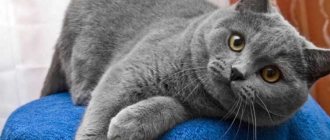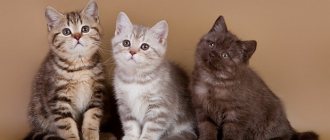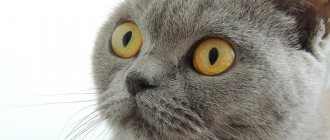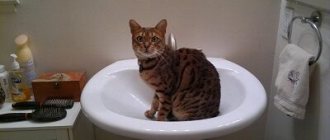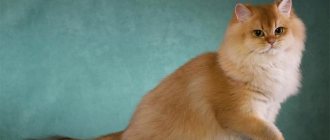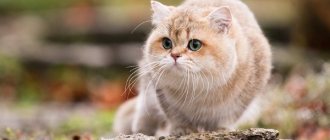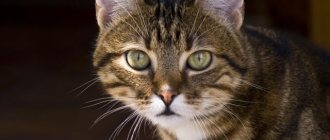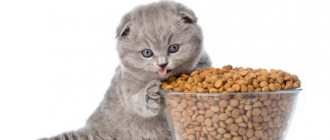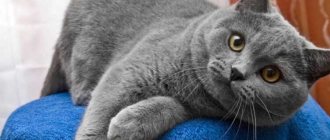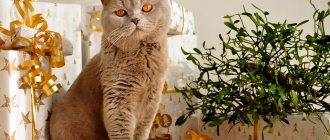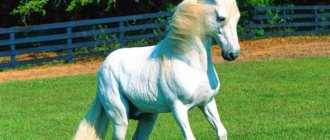Review author: “ZooVita”
The main distinguishing feature of this cat breed, from which it got its name, is its short hair, the appearance of which can be seen in the photo of a British Shorthair cat. There is no exact information about the homeland of this beautiful cat.
According to some sources, she appeared in France, while other sources claim that she is a descendant of Egyptian cats. The first exhibition at which this breed was presented took place in England in 1871.
After this exhibition, breeders and cat lovers paid attention to the British Shorthair, being impressed by the beauty of its dense coat.
The cat gained worldwide fame and distribution only in the 20th century, and was brought to the Russian Federation in 1980. Currently, the breed is popular all over the world.
Appearance of the British Shorthair cat
The description of the British Shorthair cat can begin with the fact that despite its rather large size, it has truly feline grace and elegance. This breed attracts with its beautiful, deep look and velvety coat, which is very pleasant to the touch and appearance.
If necessary, the British Shorthair can be a good hunter. The weight of representatives of the breed can range from four to eight kilograms.
He has fairly broad shoulders, a chest and a powerful body. The round and wide head has a short nose. The eyes are also round, the color of which depends on the type of breed and can be orange, blue or green.
The paws are small, but massive with thick claws. The tail has a rounded end, thickened at the base. The ears of British Shorthairs should be straight and erect, this indicates the purebred of the individual. The coat has a dense undercoat and is short and dense.
British Fold kitten
The main difference between fold-eared kittens is their small ears that hang down. They also have a hump on their nose . The head has a round shape and a clearly defined chin. The eyes of lop-eared kittens are widely spaced and slightly protruding. Since the cat's body is muscular and their legs are short, it seems that they are clubbing. The normal weight for them is considered to be 7-8 kg, so they are classified as large breeds.
In appearance, British kittens resemble a plush toy because their fur is short. The fur is usually colored one color. For example:
- Ginger;
- Blue;
- Cream.
The most popular among animal lovers are the British Blue Fold cats . This color is classic for them and comes in various shades of gray. At the level with these colors there are also such as:
- Tiger;
- Marble;
- Spotted.
And red is considered a particularly rare coloring for the British, so such a cat is considered very valuable. In addition, they have ingenuity and high intuition.
The history of the appearance of the blue British kitten
It is believed that Russian blue kittens, which were brought to England, are the ancestors of the British fold cat. In 1961, a cat was born on a farm in Scotland, whose ears hung down and was white in color. She was the beginning of the breed of British fold cats. They began to be considered a separate breed only in 2004, and before that they were classified as ordinary British.
Types of colors of the British Shorthair cat
The most common color is blue. But the colors of the British Shorthair cat are very diverse:
Solid color
The cat's fur, like its skin, should be the same color. The most widely represented color is blue, but other options are possible: black, lilac, chocolate, red and white. The rarest solid colors of the British Shorthair cat are: cinnamon and fawn.
The black color combines surprisingly beautifully with yellow eyes. The lilac color is artificially bred. The value of a chocolate-colored cat becomes higher depending on the intensity of its shade.
In short-haired dogs with a red color, the intense color is considered valuable. The White British Shorthair cat is very difficult to breed and has a high risk of giving birth to offspring with defects.
The rarest color of the cat's color - "Cinnamon" - is very much appreciated by lovers of the breed. But the rarest of the colors is considered to be “Faun”. This color is valuable because it makes it possible, during breeding, to produce offspring of new light shades.
Tortoiseshell color
Basically, females are endowed with this complex and beautiful color, while males, if they have a tortoiseshell color, are sterile. Particularly appreciated is the presence of red or cream shades on the cat’s face in this color.
Silver and golden color
Cats with such a magnificent color are also called British chinchillas. The British species with this coloring is one of the rare and most expensive.
Eye color typical for silver cats: blue, lilac or green. Individuals with a golden color are considered defective if there is a gray undercoat.
Color Point
The similarity of the British Shorthair Color Point with cats of the Siamese breed is due to the characteristic coat colors: basic white in combination with black, chocolate or red.
Tabby
An amazing feature of the British Tabby color is the presence of patterns on the coat in the form of symmetrical stripes and spots on any non-primary color. Tabby cats are very similar to tigers or leopards.
"Whiskas"
A valuable type of color, characterized by clear stripes covering the entire body of the cat, is the Whiskas color. The pattern should be as clear and contrasting as possible.
Bicolor or "Harlequin"
The peculiarity of the color is the presence of two colors, the predominant of which is white. The additional color may not be uniform and may have patterns.
Description of the breed
The main characteristic feature of the British is power, especially when it comes to males. Female cats are smaller in size than male cats. Squat height and rather large size, developed muscles and sternum - this is the image of a modern Briton.
The head of these cats is large with rounded outlines. The muzzle has developed cheeks and cheekbones. Only the British have a pronounced fold of skin around the neck.
The nose is medium long, rather wide. When viewed in profile, you can see that the nose forms a depression in the frontal part. The ears are located quite widely, with a wide base. The shape is rounded, the size of the ears is medium.
British people have large, round eyes. Set wide apart. What distinguishes British cats is the color of their eyes, characteristic of the breed - it is bright orange.
Newborns may have blue eyes, however, over time they will change their color. It is very rare to come across cats with blue or green eyes.
Medium or short llamas are equipped with well-developed strong muscles. The tail is of medium length and looks proportional to the body.
Personality traits of the British Shorthair cat
Despite the fact that British Shorthair cats tolerate loneliness quite painlessly, they yearn for an absent owner. Preferring independence, cats of this breed become attached to one person.
The cat prefers to avoid strangers, occasionally responding to obsessive attention with aggression. Possessing self-esteem, representatives of the British Shorthair are extremely restrained and not intrusive.
They have a minimal need for affection from their owner. He has a calm disposition and even in the event of aggression, he does not immediately use his claws, but only warns with a blow of a soft paw.
If there is a special claw scratcher, the cat, due to its good manners, will not damage the furniture. She is very selective in choosing her favorite places, which are always central in the home.
Representatives of the breed are very playful and prefer to have several toys. They respond well to training at an early age; it is almost impossible to retrain an adult cat.
The “British” devote quite a lot of time to their appearance, carefully licking themselves throughout the day. There are no problems when toilet training a cat, since this breed is very clean and the only nuance may be the individual selection of litter for the tray.
Character of the breed
The description of the character of the British cat says that these animals are suitable for people who spend little time within the walls of the house. These felines can cope just fine without human attention.
The British have a calm, aristocratic disposition. Even from the photo of a British cat it is clear that they know their worth and have a sense of unsurpassed dignity.
Along with this, they are very friendly and not aggressive. If they are often offended, they become withdrawn and unsociable.
If there is a child in the house, then such a cat will not be suitable for him as a fluffy toy. Otherwise, she will simply hide. British individuals get along well with other animals.
Nutrition and care of the British Shorthair cat
Although caring for a British Shorthair cat is not tedious, it does require some time. To maintain the appearance of the coat, it is necessary to comb the cat several times a week. You should not bathe your pet more than twice a year. You need to clean your ears and trim your nails at least once a month.
The diet of this breed, like others, must be balanced and contain all the necessary vitamins and minerals. Proper nutrition will help maintain your cat's health and appearance at a high level.
It is acceptable to feed your pet prepared food, but preference should be given to reputable manufacturers. Foods containing salt and sugar can be harmful to your cat.
Who is the color suitable for?
A traditional British cat with a blue color in its disposition, manners, cleanliness, and independence is suitable for:
- For lonely people, she will become a pliable, affectionate, loyal friend.
- For large families with children, she will make friends with everyone.
- For busy people who are not at home for a long time, she will not be very bored or mischievous, and will calmly wait for her owner.
Advantages and disadvantages
Striking in appearance with its beautiful, velvety, noble, blue-gray fur, the British cat has gained recognition due to its amazing character. Positive qualities include:
- unobtrusive;
- independent, self-sufficient
- does not require special care;
- experiences loneliness with dignity;
- balanced;
- clean;
- trainable;
- has a healing, calming effect.
There are no negative qualities, except for a fairly high price for a kitten; financial investments are required for maintenance. But a noble, intelligent pet will appear in the house, the joy and pride of the whole family.
Photo of British Shorthair cat
Smoky colors
“Smoky” can be any of the colors, the main thing is that the undercoat should be lighter than the main color, preferably white. This is one of the varieties of hair color distribution. About half of the hair is colored, and closer to the root half is white. There are also “cameo” colors, in which the color of the undercoat almost merges with the color of the main hairs.
Classic smoky
“Smoke” is superimposed on the same solid coat colors: black-red, chocolate-red, blue-cream, lilac-cream, as well as cinnamon-red and fawn-cream. The undercoat is silvery-white.
Smoky bicolor
The cat has a symmetrically and harmoniously distributed white color and “smoky” spots of any color. The undercoat is white, the nose and paw pads match the base color.
